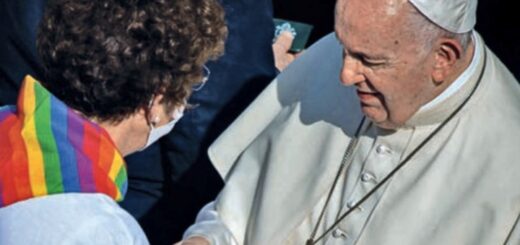Christianity and its influence on marriage and family
Text of the theologian Sister Margaret Farley* based on the book Just Love: A Framework for Christian Sexual Ethics, Continuum International Publishing Group (USA), August 2005, p. 238-244, freely translated by Giacomo Tessaro
We must not forget the substantial role of Christianity in the political and cultural conceptions of marriage and family, especially in the West. There is no need to say that the binomial Christianity-May is, like everything related to the latter, complicated and subject to personal interpretations. For example, we could start by asking us: why did the first Christians adopt monogamy? The first reason that comes to mind is that they inherited it from their culture; After all, as Theodore Mackin writes, in the early years almost all married Christians were converted adults, who had married before becoming Christians: "Until the demographic center of primitive Christianity was Palestine, the first Christians contracting Jewish marriages, Jewish for social structure and motivations". La maggior parte degli studiosi concorda sul fatto che il cristianesimo degli inizi era un movimento all’interno del giudaismo; tuttavia, il contesto culturale in cui vivevano i primi cristiani e le famiglie giudaiche comprendeva il più vasto mondo grecoromano. Nel primo secolo della nostra era il modello matrimoniale giudaico e romano era di preferenza monogamico, anche se esistevano alcune, apparentemente atipiche, famiglie poliginiche, sia in ambito giudaico che persso altri popoli [1].
Non basta però dire che il matrimonio monogamico venne adottato dai primi cristiani semplicemente perché era l’opzione più comune; dopo tutto, i cristiani si consideravano “convertiti” nel senso che si erano volti a un nuovo stile di vita, che li caratterizzava come discepoli di Gesù Cristo e portava con sé significativi impegni morali. Il desiderio di evitare “la passione sfrenata” (peraltro all’epoca non un concetto esclusivo dei cristiani) rendeva le relazioni monogamiche più adatte per i cristiani; inoltre, la monogamia faceva parte delle credenze e della teologia dei primi cristiani per il suo potenziale significato simbolico di relazione tra Gesù Cristo e la Chiesa, ed anche per la sua affinità con il concetto cristiano di amore per il prossimo. Se il cristianesimo si sarebbe adattato ad altri modelli di matrimonio è una questione aperta ma, a mio avviso, abbastanza oziosa (per quanto non lo sia affatto in termini di dinamiche interreligiose e interculturali).
Even the Roman laws and customs, based on mutual consent, proved to be easily adaptable to Christian faith and mentality. The Christians, like the culture in which they lived, thought that marriage was a family deal, even if it was the mutual consent of the spouses who made it possible. The practice of having Christian shepherds present at the wedding gradually arose and informally.
However, Christians had a different attitude towards marriage: as Mackin writes, the eschatological expectations of the first Christians made marriage appear as something irrelevant, even if one of the main reasons to get married continued to be the sexual needs of individuals. Marriage as such was not very important for the spread of the good news [2].
This introduces us to another important question about the role of marriage in the Christian Church, from the early years up to several centuries later: despite the fact that it could be in harmony, both with the dominant culture and with the Christian faith, the role of the family and marriage in the Christian community remained ambiguous, and for many reasons. One of these is that Christians believed they live in "time of the end": The marriage was therefore relative by hope in theeschaton.
Un’altra era la concezione scettica della sessualità umana, secondo cui la rinuncia al sesso era una scelta ragionevole per alcuni. Il cristianesimo, come abbiamo visto nel capitolo 2, emerse nella tarda epoca ellenistica, quando perfino il giudaismo era influenzato da una concezione pessimistica del sesso. Osserva Ruether: “Sia il mondo grecoromano che quello giudaico del primo secolo comprendevano movimenti e ideologie contrarie alla famiglia” e, possiamo aggiungere, contrarie al sesso in un modo o nell’altro.
Erano ben note alcune filosofie che predicavano la vita celibataria per mantenere la mente libera per il pensiero e il cuore sgombro, soprattutto senza una famiglia da mantenere. Presso gli Ebrei esistevano comunità organizzate per i celibi, ma in nessun altro gruppo in rapida ascesa l’idea di rinunciare al matrimonio e alla famiglia per dedicarsi pienamente a Dio e al servizio del Vangelo fu così forte come nelle comunità cristiane. Pur avendo i primitivi autori e predicatori cristiani affermato che il sesso era cosa buona, come parte della creazione, erano al tempo stesso convinti che esso fosse il paradigma dei danni causati dalle forze distruttive della Caduta morale. Perciò, prendendo esempio da Paolo, chi riusciva a non sposarsi per il Regno di Dio veniva incoraggiato nella sua intenzione.
Lo studio di Peter Brown sulla “rinuncia permanente al sesso” Among the men and women of Christian circles between the 1940s and 430 DC constitutes an analysis of the facets of this phenomenon. One thing is clear: not all the choices of celibacy made in this period were due to a negative evaluation of sex.
Paolo's motivations were based on the freedom to announce the Gospel, a pragmatic motivation that did not depend on a denial of sex. Others chose celibacy for other reasons: the soul could transform the body; The conversion of the heart was favored by the integration of affections for God carried out in celibacy; The lack of sexual availability of women could overthrow gender expectations; Friendship could be more pure if it transcended sexual intimacy; The rigorous asceticism included the repudiation of sex; The renunciation of sex was comparable to martyrdom, because it ensured the total donation of self to God; The death and resurrection of Jesus were conceived in such a way as to make sex irrelevant. Brown finds all these forms and motivations for permanent celibacy to emerge, develop and compete together and with spousal chastity. None of these reasons was extraneous to society as a whole and most of them were the subject of intense discussions. All this, however, does not exhaust the ambiguity of the marriage condition for the first Christians.
According to Rowan Greer, the church of late antiquity showed at least three attitudes regarding marriage and family: their combination was in a profound ambivalence. The first attitude was apparent refusal of family ties, if not of open hostility towards the family. The Christian message was a division sword that opposed the members of families against each other (Matthew 10: 34–39; Luke 12: 51–53).
In a sense, all Christians were required to leave everything, including father, mother, spouse and children (Matteo 12:25, 22:30; Luke 20:35). Believers lived in the anticipation of a new era, in which the marriage would not exist. The Christian attitude towards martyrdom sometimes manifested an extreme form of refusal of family responsibilities. The women abandoned their husband and children for "Running the martyrdom" And men were sometimes encouraged to forget the wealth, his wife and children, the brothers and sisters and ensured them that the renunciation of human bonds would bring new spiritual ties and the freedom to announce the Gospel.
The second attitude, strongly linked to the first, was given by the fact that the first Christians they considered the Church a substitute for traditional families: The Church was their new family. Who was without a family (for example, widows and orphans) now enjoyed the protection of the Church; Who had had to leave his because of the Christian vocation and the divisions he could create, found a new hearth in the Church (Matthew 10: 29-30). The Christian community offered a group of belonging that promised to abolish every barrier of nation, gender and economic condition and also offered a shared life and a community identity that had precedence over any other belonging, including the family one.
Finally, in tension with the first two attitudes, Christians also believed that the marriage and the family in the current sense could be confirmed, not abolished, from their new life of faith. "Leave everything" He could buy a different meaning for those who were called to live in a traditional family (acts 10: 2; 11:14; 16:15), that is to say that altruistic love necessary for family relationships, the obligation for families to share their assets with the needy, or a form of "detached commitment"For a significant part of life which, nevertheless, was destined to pass.
Most of the Christians obviously chose marriage, which constituted a way of life in which the Church had its interests. The domestic hearth, for Christians as well as for the Jews, the Greeks and the Romans, was essential for primitive urban Christianity; There is therefore no surprise if some Christian leaders were alarmed by the real and potential consequences of the attitude of refusal of the family, an attitude that endangered marriages and attracted poisonous criticism by external observers.
To soothe or prevent these consequences, the leaders related to Paul began to promote codes of family behavior in their communities (Colossians 3: 18–4: 1; 1 Timothy 2: 8–15; Ephesians 5: 22–33; 1 Pietro 2: 11–16; Tito 2: 2–10); based on the imperial model of the subordination of the whole family al pater familias, these codes accepted slavery and strengthened the domain of husbands on the wives. Although they are sometimes interpreted as a praise to marriage and the family, their taxation did not reflect the "at all"new order"So important for the first Christians; the message of these codes was that Christian families had to adapt to the social order in which they lived.
However, the message of the first Christians remained ambiguous and ambivalent, in the tension between the attitudes of refusal, replacement and confirmation. In the third century, these three attitudes contributed to a position that opposed both the hostility in the face of marriage and the typical sex of some Gnostic groups (as they were painted by the Church Fathers), and to the suppositories of others. For many centuries the Christian Church has continued to preach that the marriage was good, but the celibacy was better. The positivity of the family invariably resided in its socializing function for the children and in the order he brought to society.
It has been argued that Christian ambivalence towards marriage and family, maintained for so many centuries, is served by criticism of the practices in force in the Roman Empire and that it has operated to transform some traditional versions of those institutions.
Family codes aside, Christianity was an implicit judgment of the family as an expression of worldly powers; On the one hand, however, Christian teaching changed very little the general characteristics and the structure of the Grecoromani marriage and family: the pater familiasIn one way or another it continued to reign and the domestic hearth always reflected the order requested by the dominant culture.
On the other hand, however, much of the eschatological relativization of marriage and the family, typical of the primitive Church, did not be lost. Although at the marriage, in the twelfth century, the dignity of the sacrament was granted, a lower vocation remained, relatively less significant than celibacy and mostly instrumental to the relationship with the Church and society. Even the key developments of marriage and family theology did not change their place in Christian life, while questioning particular themes, such as the nature of the spousal bond and the purpose of sexual activity.
Only in the fourteenth century Christian self -understanding began to change significantly, in order to allow a new conception of marriage and family life. Subsequently, the humanists of the Renaissance shifted attention from the world of spirit to social responsibilities, from renunciation of sex to self -discipline and success, in a world where family and production work began to associate.
The Protestant reform then gave the definitive impulse to this movement and consistently articulated a new conception of the role of the family in Christian life: marriage and family replaced celibacy as a center of sexual gravity and primary unity of Christian life. As we saw in chapter 2, Martin Luther and Giovanni Calvino did not change the traditional Christian suspicion against sexuality, but accepted the sinful sides of it as part of human nature after the fall. Sex could not come "justified", Neither from procreation nor from anything else; could only be forgiven, and the place where he forgive him was heterosexual marriage.
The care for unbridled desire was the tame through the responsibility of maintaining a family and raising children. Furthermore, for Luther, the primary ethical need for the Christian was love for others, and precisely in the institutions of marriage and the family the obedience to God, patience and what served to love others was learned. Through marriage, sexuality could be channeled towards the meaning of life as a whole.
In the traditions Lutheran and reformed subsequent disappeared the primitive Christian ambivalence towards marriage and the family. The Christians (with rare exceptions) were now called to the holiness and service of others, the closest one (the spouse and the children) and the most distant society). The removal of ambivalence was so radical that, for example, women had very few alternatives to the life of wife and mother. Until the cultural changes of the 19th century led to the separation of the private world of the family from the public world of productive work, the Christian interpretations of the "female nature"They bordered the woman exclusively in the private and domestic sphere.
Obviously the history of Christian marriage does not stop at the reform, but the beliefs and practices of the major Christian traditions were now fixed. Even if until the second half of the twentieth century significant differences between Catholics and Protestants regarding our theme have never been missing, now the two traditions show parallels in the interaction with the cultural changes that took place between the 17th century and the XXI: today Christian families are like almost all the others in the West, their problems are completely similar: gender relationships, diversity of family forms, structural changes and destabilization due to a perpetual change culture. After this sketch of the history of marriage and the family, therefore, I will examine these institutions for how they present themselves today.
_______________________
[1] Ross S. Kraemer observes: "... if [the polyginic marriage] was more common than we think, it is currently impossible to establish", given that "We know little about the family practices of ordinary people". Kraemer, together with others, also observes that in antiquity there was little Jewish characteristic in Jewish families; Citing Shaye Cohen, says Jewish families "In their structure, in their ideals and in their dynamics they seem to be practically identical to those of the surrounding cultures".
[2] This does not mean that marriage and family were not, in many ways, extremely important for Christian churches since the early years; As original places of worship, places of hospitality and centers of moral growth and education, it is difficult to imagine Christianity develop without them.
* Sister Margaret A. Farley, born on April 15, 1935, is part of the American Congregation of Sisters of MercaY (Sisters of Mercy) and is a professor that emerged from Christian ethics at the Yale University Divinity Schoowhere he taught Christian ethics, from 1971 to 2007, and was also president of the Catholic Theological Society of America (Catholic Association of America's theologians). His bookJust Love (2005), he had numerous criticisms and censorships by the Congregation of the doctrine of faith For the moral opinions expressed, considered divergent by the Catholic magisterium, but instead received broad support and approval from Leadership Conference of Women Relligus (Conference of religious women of the United States) and the Catholic Theological Society of America (Catholic Association of America's theologians).






